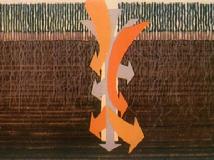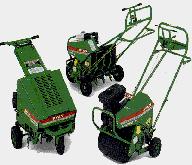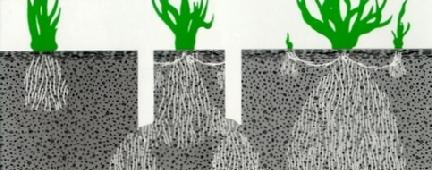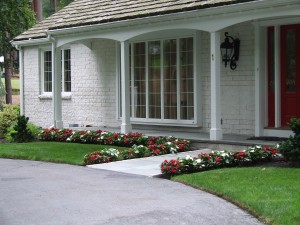What Is Lawn Aeration?
By definition, Lawn Aeration is the process of mechanically removing small plugs of thatch and soil from the lawn to improve exchange of necessary nutrients (air, water, fertilizer). In other words, increasing your lawns ability to breathe and absorb the nutrients it needs to maintain its health.
What Are The Benefits of Lawn Aeration?
- Improved Air Exchange Between the Soil and Atmosphere
- Improved Soil Water Uptake
- Improved Fertilizer Uptake & Use
- Improved Turfgrass Rooting
- Improved Thatch Breakdown
- Improved Heat and Drought Stress Tolerance
- Improved Resiliency and Cushioning
- Reduced Water Runoff
- Reduced Soil Compaction
What is Soil Compaction and Thatch Breakdown?
Soil Compaction
Most lawns, particularly heavily used ones, have compacted soil, which restricts the movement of air and water to the root zone. Walking, playing and mowing are forms of traffic that compact soil and stress lawns. Raindrops and sprinklers increase soil density by compacting soil particles and reducing air spaces where roots may readily grow. Core aeration helps heavily used lawns and lawns growing on compacted soils by improving the depth and extent of turfgrass rooting, allowing better water uptake, and speeding up thatch breakdown.
Thatch Breakdown
Most lawns are subject to thatch accumulation. Thatch accumulates faster on heavy clay soils than other types but, a layer of only 1/2″ keeps air, light and water from getting to the root zone. Core aeration breaks through dense thatch and opens up the soil to permit free movement of water, fertilizer and air. Even the cores left on top of the lawn after aeration have their own thatch reducing mission. It takes about 7-10 days for the cores to break down and dissolve back into the soil. The bacteria in the cores reduces the thatch layer naturally by allowing the micro bacterial organisms to speed decomposition of remaining thatch.
When Should Lawns Be Aerated?
Annual aeration is recommended and both spring and fall are ideal times to aerate. Spring aeration should be performed between March and May; Fall aeration is done between September and November and can be combined in a lawn renovation project including “De-Thatching” and “Slice Seeding” (see below). Recommended Aeration times are listed within the Seasonal Calendar document that you may download, print and refer to throughout the seasons.
Will Aeration Machines Damage My Underground Sprinklers?
No. All properly installed Sprinkler Systems are safe from our Aeration machines. We avoid raised heads and exposed lines whenever possible – but if you’re concerned for your system, we would be glad to have the employees of Fulchino Irrigation assure its safety. The machines we use for Aeration are shown below.
What Should I Expect After Lawn Aeration?
- Immediately following aeration, your lawn will be covered with small plugs of soil and thatch – don’t panic!! Within a week or two these plugs will break apart and disappear into the lawn.
- During this time period the Aeration holes will fill up with white actively growing roots. This is the earliest sign of beneficial activity as a direct result of lawn aeration (see illustration below).
- Water puddling will be reduced and your lawn should be able to go longer between waterings. With repeat Aerations your lawn will be more heat and stress tolerant.
Watering Tips
Our recommendation for watering in Massachusetts is as follows:
- Water mornings or evenings during specific times of the year (usually March – April and July – November).
- Water early mornings only during hot, humid weather to minimize and even prevent fungus (usually May – June).
- If you have annual flowers you may need a midday watering to help them survive during the hot summer months.
Please read the supporting statement from UMASS Extension below;
Effective Watering Practices
(Adapted from UMASS Extension, 2000)
Frequent lawn watering often encourages shallow rooting and may predispose the lawn to increased disease and greater susceptibility to stress injury. Watering deeply and less frequently provides for improved turf growth and increased water conservation compared to light, frequent watering.
When irrigation becomes necessary, wet the soil to a minimum depth of 4 to 6 inches. This amount of water varies with soil texture, but approximately 1 inch of water should thoroughly wet most soils to a depth of 4 to 6 inches. Placing several empty cans (tuna or cat food cans work well) under the sprinkler allows you to determine when an appropriate amount of water has been applied.
Irrigation can be applied at any time during the day or night. Both day and night watering have advantages and disadvantages. Midday watering cools the turf and reduces heat stress on hot summer days. If drainage is poor, pools of standing water can become very hot and result in turf death due to scalding. Midday watering is also relatively inefficient due to substantial evaporation losses. Night watering may incite or aggravate disease problems. However, the turf is usually wet during the night anyway, even if irrigation is withheld, because of dew formation. Recent research has suggested that the duration of leaf wetness (the number of hours that the leaf blade is actually wet) has a greater impact on disease incidence than night watering per se. In that case, watering during early evening or late morning (just prior to or following dew formation) could result in increased disease by prolonging leaf wetness. Night irrigation helps to conserve water because of minimal evaporation at night. Night watering should be avoided, however, when disease is present and actively damaging the lawn, or during periods of very hot, humid weather. Very early morning watering, before dew has dried, is the best solution, because it provides for efficient use of water (low evaporation) and does not contribute to disease pressure.








